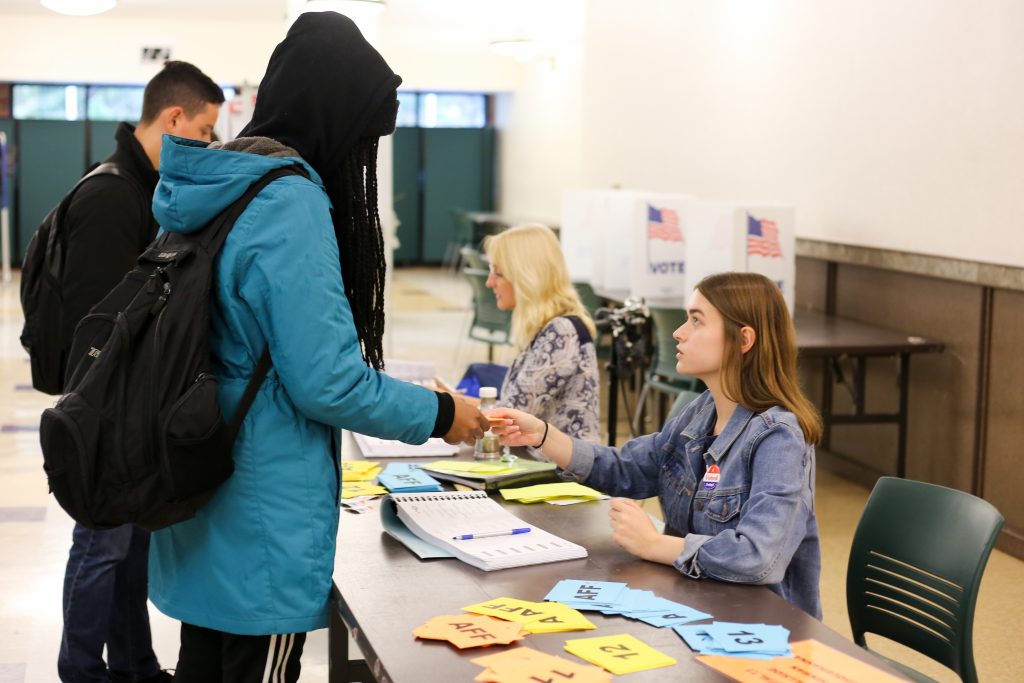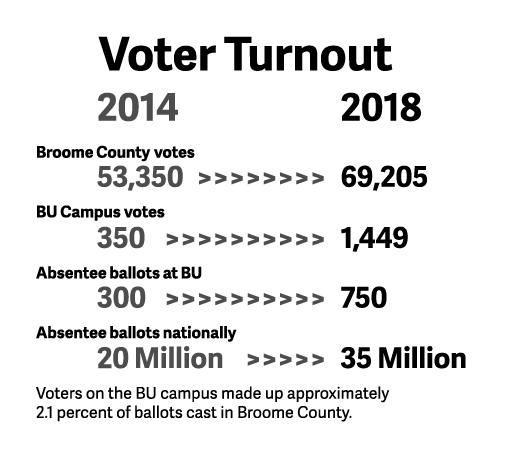
In an election that energized voters across the United States, Broome County and Binghamton University saw several parallels with other areas of the state and country.
Despite rainy weather on Tuesday, voters came out in droves to vote on campus and across Broome County, following statewide and national trends.
The county saw a total of 69,205 votes, not counting absentee ballots, an increase of 15,000 votes from the 2014 midterm elections. The number of votes counted in Tuesday’s election is roughly 19,000 fewer than those cast in the 2016 presidential election.

“Gubernatorial and midterm elections have not, in the last few decades, really grabbed the attention of students across New York state,” DeAngelis wrote in an email. “But this year, with national attention on the importance of midterms, we saw a real jump in campus voter turnout. While about half as many students cast ballots on campus as in the most recent presidential election, nearly four times as many students voted on campus yesterday as did in the last midterm year.”
According to Jonathan Krasno, a professor of political science at BU who researches public opinion, congressional elections, campaigns and campaign financing, turnout increases with interest, which drove Tuesday’s turnout.
“In this case we had a bunch of things going on to drive that interest, starting with one of the most competitive House elections in the country with lots of campaign ads and coverage,” Krasno wrote in an email. “Plus, there was the sense that President Trump had labelled the election as something of a referendum on him [if Republicans won], which certainly motivated plenty of voters who support and oppose him, with campus falling firmly among the opposition.”
However, in addition to more students voting on campus, the CCE saw a large increase in students voting via absentee ballot, sending in their votes early to their home districts. The rise in absentee ballots among young voters is in line with national trends — for the 2018 midterm elections, unofficial results indicate more than 35 million Americans, many of them voters aged 18 to 29, cast early ballots, a 75 percent increase from 2014 elections.
“We have seen a rise in the number of absentee requests that have come through the CCE,” DeAngelis wrote. “In 2016, approximately 300 students requested absentee ballots through our office. This year more than 750 requested absentee ballots through our office. Without having any survey data in front of me, I might attribute that to the difference between a presidential year, [when] students can receive their ballot anywhere and still have an opportunity to participate in the presidential race, and a midterm election year, where students may feel some direct connection to the members of Congress or other state and local-level representatives who are running in their home districts.”
With a large number of voters came several notable election results. In many local races, including several races for Broome County Legislature seats and the race for Broome County sheriff, winning candidates easily took the election.
Republican incumbent David Harder won the Broome County sheriff’s race by a landslide, despite seeing protest over inmate deaths and conditions in the Broome County Jail during the last half of his term. He won roughly 77 percent of the vote across the county, trouncing his Democratic opponent, former city of Binghamton mayor Matthew Ryan. Harder will start his sixth term in office in January.
Similar victories were seen in student-populated districts for Broome County Legislature races. In Broome County’s 4th district, which encompasses the University’s Vestal campus, Democratic incumbent Daniel Reynolds won 71.3 percent of the vote, and in the county’s 14th and 15th districts, Democratic incumbents Mary Kaminsky and Mark Whalen both won with more than 60 percent of the vote.
Additionally, several local representatives were running unopposed. State Sen. Fred Akshar will again be representing the 52nd district in Albany come January, and Assemblywoman Donna Lupardo also won re-election. Because they had no opponents, both were elected with more than 95 percent of the vote. Lupardo saw roughly 29,400 votes and Akshar received about 51,700.
But at the state and federal level, the election cycle highlighted discrepancies between campus and Broome County results and statewide election results for New York races. In the governor’s race, New York voted heavily for Democratic incumbent Andrew Cuomo and his running mate, Kathy Hochul. Cuomo won 59 percent of the statewide vote, besting his 2014 showing and securing a third term. Nevertheless, in Broome County, Republican Marc Molinaro won the popular vote, beating Cuomo by roughly 9 percentage points and 5,600 votes. Cuomo only won in six upstate counties — Ulster, Albany, Tompkins, Erie, Onondaga and Monroe counties — but saw wins in Rockland and Westchester counties, New York City and Long Island.
“It’s an honor to fight every day for every New Yorker,” Cuomo tweeted roughly an hour after his victory was confirmed. “New York will always lead the way forward.”
In other statewide races, Democrats won Broome County, but did so with markedly smaller margins than in other areas of the state. State election results show Democratic incumbent Thomas DiNapoli capturing the comptroller race with almost 67 percent of the vote, but in Broome County, he only received about 58 percent of the vote — a nine point difference. Similarly, Letitia James, Democratic candidate for attorney general, won her race with around 62 percent of the vote statewide, but only received 49.4 percent of the vote in Broome County, narrowly winning the county over her opponent, Republican candidate Keith Wofford, by about 2 percentage points.
“Tonight we made history,” James tweeted on Tuesday. “This is a night for justice, a night for our future. I am proud to be a New Yorker who knows it’s our diversity, strength, courage and determination that makes us great. As your Attorney General I promise to fight for all of us.”
The attorney general’s race was not the only close election on local ballots. For two candidates, the election might not be over. The expensive and contentious race for New York’s 22nd congressional district has yet to be fully decided, with final results hinging on more than 13,000 absentee ballots that have yet to be counted across the district.
Currently, unofficial election results show that Democratic candidate Anthony Brindisi has the lead by 0.6 percentage points — just 1,422 votes. The Associated Press and CNN called the race for Brindisi around 11 p.m., and he gave a victory speech in which he pledged to communicate with constituents in his district during his time in office.
“It’s going to be my job to represent all the people in this district,” Brindisi said. “Not just the people that voted for me, all the people. So for those who did not vote for me let me say this — my door is always open, I will always listen.”
However, Tenney has yet to concede the race. At her election party in New Hartford on Tuesday night, she said she was not giving up and suggested the possibility of a recount as her supporters chanted “No concession.”
“I’m certainly not going to give up the fight,” Tenney said.
In a statement released later on Tuesday night, Tenney thanked supporters and echoed her comments from the election party, refusing to concede the race until absentee ballots are counted. It is unclear when the eight counties in the 22nd congressional district will begin counting those votes, but according to election officials, it could be weeks. Election officials will also have to consider thousands of sealed affidavit ballots, or ballots cast by voters who have lapsed registrations, that were cast on Election Day and determine if they are valid and should be counted.
“With over ten thousand absentee ballots left to count, this race is still too close to call,” wrote Raychel Renna, Tenney’s campaign manager. ”Over the next few days and weeks our team will participate in the re-canvass process and review the absentee ballots.”
Prior to election night, the race was considered a toss-up, and was expected to be one of the closest U.S. House of Representatives races in the country. In the days leading up to the election, both campaigns ran a barrage of advertisements across the district, and while Tenney brought several high-profile Republicans to the Southern Tier and central New York, including Donald Trump Jr. and Press Secretary Sarah Huckabee Sanders, Brindisi appeared at community events and panels throughout the region.
Several days before the election, a New York Times poll showed Tenney ahead of Brindisi by 1 percentage point. A Siena College poll released on Oct. 24 also showed tight results, with Brindisi leading Tenney by 1 percentage point.
But although the race across the district is tight, in Broome County, unofficial results show Brindisi led Tenney by more than 10 percentage points on election night, with about 55 percent of the vote. Roughly 7,800 votes separated the two, the largest margin of any county in the 22nd congressional district.
According to Krasno, it is likely Brindisi will still win the race, despite the absentee ballots yet to be counted.
“Even if there are 15,000 absentees uncounted, Tenney would have to win them by nearly 55-45 to overcome Brindisi’s lead of 1,422 votes,” Krasno wrote. “That seems very unlikely, especially since several of the counties — but not Broome, Brindisi’s best county — have released [information] about the party registration of the absentee voters, who are pretty much evenly split between Democrats and Republicans.”
In Broome County, Krasno wrote he believes students played a large role in Brindisi’s 7,800 vote advantage. According to Krasno, BU students might be a big part of what gets Brindisi elected, if he ultimately wins the election.
“I think it’s very likely that Brindisi won campus by 50 or 60 points,” Krasno wrote. “Even if just 1,100 voters voted for Congress, that’s a 550 to 660 vote margin for him from campus — not counting the votes of students who live off campus. That’s not Brindisi’s whole margin of victory, but it’s an awfully big chunk of it. He should be very aware of the role our students likely played in his win, [if he actually won].”


